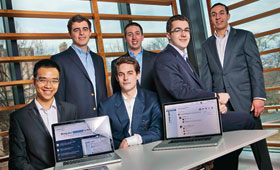
Mar 18, 2013
Students Create Course Management Site
During spring semester, six professors are testing a new course-management system called AcademicConnect, created by Lafayette students. John Frazier ’15…

by Dan Edelen | illustration by Dale Mack
He was young and bold, possessing a singular vision to make a “startup venture” on the other side of the Atlantic work. Capital, resources, powerful investors— he needed them all, and he wasn’t afraid to ask because he understood they would help him change everything.
A man of adventure, the Marquis de Lafayette took risks, and he knew that the greater risk was the failure to try. He had a motto that reflected that can-do spirit: “Cur non?”
Why not?
In the end, he made a difference that indeed changed everything. And his spirit lives on in the lives of students and alumni from a College named in his honor, who are forging their own new directions toward a better future for all—through entrepreneurship.
“The entrepreneurial spirit is defined by a sense of adventure, a passion for excellence, and an underlining sense of hope and vision for future possibilities and achieving them,” says Karen Fried Young ’84. Striving for that hope, Young encouraged daughter Sophie to read to Alzheimer’s patients, starting with Young’s own mother. In 2010, this effort became Sweet Readers, a 503c charity that connects middle-schoolers with Alzheimer’s sufferers, bringing encouragement through reading and other activities. Programs take place in museums, libraries, day programs, schools and assisted-living facilities and are being modeled and replicated across regions and cultures.
Previously, Young, an economics and American studies graduate, bucked conventional thinking and entered the cutthroat toy and game industry, achieving success through a line of popular board games including Think-It Link-It and Zing! launched by her TLI Games, which she sold in 2008. “Being an entrepreneur means you see possibilities where other people see obstacles.”
Nurturing the spirit behind the Marquis’ notable motto defines the experience that students find at Lafayette. At a time when technology and the creative arts continue to converge in exciting ways, the College sets the standard in bridging disciplines, in “cross-training” the mind and body, which many alumni entrepreneurs cite as a powerful source for inspiration and innovation.
“Though I was an engineer, I also took philosophy courses,” says Hal Kamine ’78, founder of Kamine Development, CEO of KDC Solar Inc., and chair of the Board of Trustees Committee on Grounds and Buildings. He likens the numerous interdisciplinary studies and opportunities at the College to a “smorgasboard” that better equips students to create the future’s innovative ventures. When coupled with a strong emphasis on availability of professors in a small college environment, it “helps students see opportunities outside of their realms of major concentrations.”
Kamine has founded several highly successful technology companies including KMC Telecom, which become one of the country’s largest independent competitive local exchange carriers.
That cross-pollination of ideas among academic departments at Lafayette is reiterated by Jeffrey Fry ’81, president of Help Find Care and Seda Rico LLC. As the founder/ co-founder of nearly a dozen small enterprises, Fry recalls the telling observation made by his grandfather, Macon Fry, a nuclear physicist and MIT grad who held multiple high-tech degrees: “The most well-rounded engineers he had ever met went to Lafayette.” Fry balanced his own electrical engineering studies with event-management skills when he helped bring The Grateful Dead to campus and successfully managed associated merchandising—his first entrepreneurial venture. “I always knew I would be in a technical field,” he says, “but I did not know the liberal arts environment would help prepare me for my entrepreneurial journey.”
Few who undertake that journey do so alone. The risks involved with leading require wise counselors who can share in imagining what lies beyond the horizon.
In 2008, Tyler Vernon ’00, contrary to prevailing wisdom, predicted a 20 percent drop in U.S. stock values on Fox Business News. His Biltmore Capital Advisors was founded shortly before that appearance. When markets later collapsed, Vernon was sought out by The Wall Street Journal, CNNMoney, and other respected fi nancial media sources, and became a regular contributor.
Vernon credits Don Chambers, Walter E. Hanson/ KPMG Professor of Business and Finance, with drawing alongside him, guiding him professionally. “It speaks highly of Lafayette that Don continues to help and work with me more than a decade after my graduation for no pay other than the satisfaction of continuing to help a former student. He’s the kind of person, teacher, and mentor that makes Lafayette a special place.”
Hal Kamine agrees. The best way to ensure success as an entrepreneur? “Find a mentor.”
An English graduate and co-founder and CEO of Tykoon, which makes financial education software for youngsters and their parents, Mark Bruinooge ’93 looked to James Lennertz, associate professor of government and law. “He constantly challenged students and their approach to analyzing an issue. He also demanded well-informed participation. I went to his classroom only if I was well prepared and ready to contribute. I believe entrepreneurs must embrace these conditions to achieve success.” Karen Fried Young also cites Lennertz as an influencer, his passion for his field leaving a lasting impression.
Growing up in the Jamaican community in the Bronx, Terese Sydonna Brown ’07 learned sewing from her grandmother. Now she’s the driving fashion force behind the Terese Sydonna Collection. “Being president of the Association of Black Collegians, volunteering with the Landis Center Adopt-a-Student tutoring program, and coordinating Lafayette’s first two fashion shows all taught me the importance of leadership, teamwork, listening, and inspiring others to reach their full potential.” Of that full breadth of opportunities, she says, “When I left Lafayette with study-abroad experience, an honors thesis in studio art, and the beginning of a business plan, I felt I could conquer anything.”
Leadership, vision, creativity, optimism, research skills, intuition, team-building, focus, tenacity, and passion. Lafayette alumni who build new companies and organizations, who develop new products and services, share common traits.
One other factor contributed for many.
“Relationships with people who had different strengths and interests were useful in developing a holistic sense of how things work,” says Jay Santamaria ’71, founder of G2 Collective, a leader in eTeaching and new educational delivery systems. The sense of community found in a small college environment encourages people to take risks, to succeed—and fail—graciously. “The social life at Lafayette taught me the importance of building long-term relationships based on trust and shared values,” says Santamaria, a history graduate.
The lifeblood of any entrepreneurial effort, relationships help ensure growth.
“Being a fraternity social chairman taught me to juggle tasks and personalities as well as a five-figure budget each semester,” says Scott Schaible ’86, an international affairs graduate who invented Quiet Spot, a pet tag covering that stops the annoying jingle of collars. It is marketed through his pet-accessory company, Itzadog. He also co-founded Billboard Ecology, which diverts retired advertising billboards and banners from being tossed into landfills and repurposes them into products such as totes and lunch bags.
Greek life benefited Karen Fried Young too. She was involved in her sorority, Kappa Kappa Gamma. In addition, she co-chaired the Annual Fund phon-a-thon, served as photography editor for The Lafayette, and helped with first-year student orientation. “All these activities contributed to learning to work well with others on a team,” she says, “to being a confident hopeful leader, and to not shying away from risk. Best of all was being part of a community and having a leadership role in making the community better.”
While a strong sense of community sparks creativity, those who discover new vistas understand the need for individualism. Stepping out from the crowd and taking ownership of the risk for doing so is inherent in the entrepreneurial spirit.
Graduating with an international affairs degree, Amy Herman ’88 initially trod a traditional path toward a legal career. But Bob Mattison, Metzgar Professor of Art, kept in contact with her after graduation and helped nurture an alternate career direction. “With his support, I returned to graduate school to study for a master’s in art history and with his continued encouragement, remain confident that I also will complete my Ph.D.”
Herman now helps others see differently through her company, The Art of Perception, which uses art as a tool for enhancing critical observational skills. “The College provides a wide array of speakers, symposia, and artists-in-residence, bringing so many facets of the world—and for me, the art world—to campus to engage and inspire students. So many concerts, exhibitions, and speakers brought to Easton sparked a passion in me to learn more about how I could contribute to the art world in a meaningful way.”
“There was suffi cient freedom on campus so a student could live, learn, and feel independent,” says Scott Schaible, who walked his own unique road. Marketing guru Seth Godin called the Quiet Spot tag silencer “an incredibly dumb idea.” Schaible persisted in his singular belief in what proved to be a hit product, getting the last laugh, with Godin confessing in his Purple Cow series of books, “I’ll also admit I’m wrong.”
The swing and miss. The idea that blows up—in a bad way. Failure is inherent in the creative process for those who live on the edge of innovation and pursue the next big thing.
“In victory, I learn a little; in defeat, everything,” says Fry, paraphrasing a sentiment that some attribute to the Hall of Fame pitcher Christy Mathewson and some to an ancient Japanese proverb.
Bruinooge says, “Lafayette presented me an opportunity to explore, experiment, and discover in a supportive and competitive environment. The College embraces success and also accepts failure as a positive driver in learning.”
Surely all the entrepreneurs agree with Teddy Roosevelt: “Far better it is to dare mighty things, to win glorious triumphs, even though checkered by failure, than to take rank with those poor spirits who neither enjoy much nor suffer much because they live in the gray twilight that knows neither victory nor defeat.”
